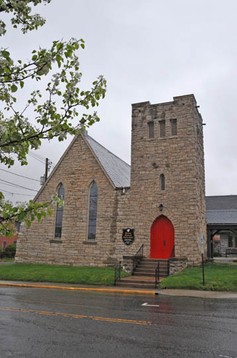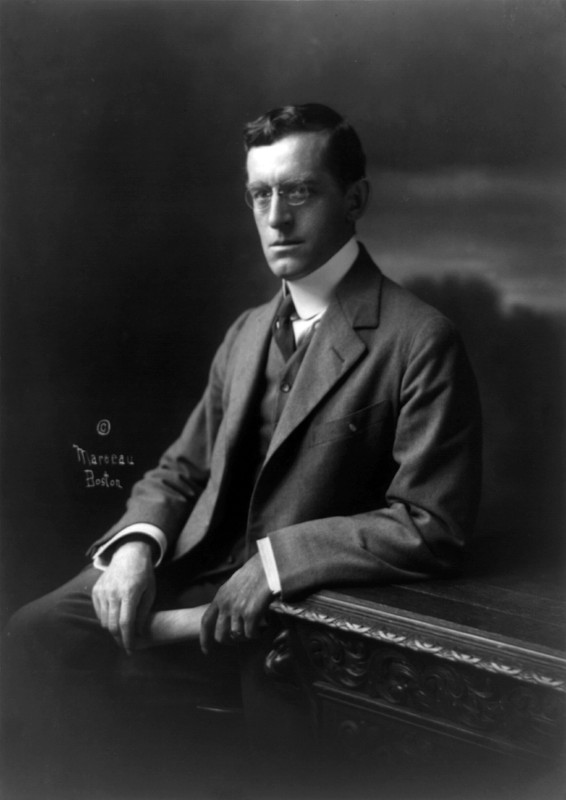Christ Episcopal Church
Introduction
Text-to-speech Audio
Located in Blacksburg, Virginia, Christ Episcopal Church was built as part of missionary efforts to establish Episcopal churches west of the Blue Ridge Mountains during the mid-1800s. This particular church was founded in 1858, though the outbreak of the Civil War delayed construction on the edifice until circa 1874. The building has seen a number of additions over the years, including a 1934 bell tower erected under the supervision of noted collegiate and ecclesiastical architect, Ralph Adams Cram. Christ Church is a contributing structure within the Blacksburg Historic District.
Images
The Christ Episcopal Church is a contributing structure to the Blacksburg Historic District; image by Jerrye & Roy Klotz, MD - Own work, CC BY-SA 4.0, https://commons.wikimedia.org/w/index.php?curid=39584828

(1911) Ralph Adams Cram, noted American Architect

Backstory and Context
Text-to-speech Audio
In 1785, following the American Revolutionary War, the Protestant Episcopal Church emerged out of former colonial Anglican churches. The Episcopal Diocese of Virginia was established, though it struggled to retain membership after the passage of the Acts of Disestablishment. The Acts, issued by the Commonwealth of Virginia, resulted in the seizure of church property—including the glebes on which the clergy resided. Episcopal churches experienced the lowest ebb in the early 19th Century. Consequently, missionary efforts to establish Episcopal churches west of the Blue Ridge Mountains began in the 1840s and 50s.
Missionary activity occurred in the area of Blacksburg where, during the Revolutionary War, attempts to form an Anglican congregation were stymied. The majority of the English-speaking populace in the area of Blacksburg were Methodists or Presbyterians. These groups felt discriminated against by the Church of England. Many of members of these denominations were not receptive to the newly-established Episcopal Church. Nevertheless, in 1858, Christ Church was founded, largely owing to the work of a missionary priest of the Diocese of Virginia. Members of the Preston Family of Smithfield were also instrumental to this effort.
The outbreak of the Civil War curtailed missionary work in the New River Valley and delayed the construction of Christ Church. Work on the edifice did not begin until about 1874. This structure, designed by New York architect Emlyn Littel, was the first church in the county to reject the simple nave plan in favor of a side entry, chancel, and pointed windows. Additionally, it incorporates Gothic decorative and structure motifs, such as exposed wood roof trusses and buttresses. The first service was held in March 1875, and the structure was consecrated on September 25, 1887, by the Right Reverend Alfred M. Randolph, assistant Bishop of Virginia.
Since then, the interior of Christ Church has changed very little—with the exception of an added brass lectern and pulpit, as well as an altar to replace the original communion table and the repositioning of organ pipes. The exterior has received several additions: in 1934, a bell tower was erected under the supervision of noted collegiate and ecclesiastical architect, Ralph Adams Cram; a parish house was constructed in 1942; an educational wing was completed in 1972; the present parish hall was built in 1990. Finally, in 2011 and 2012, Christ Church underwent a restoration effort to restore the church buildings to their original appearance.
Christ Episcopal Church is one of 137 contributing structures (and 2 contributing sites) within the Blacksburg Historic District in Montgomery County. The district, which encompasses an area of 72 acres, includes commercial, residential, and institutional buildings in a variety of architectural styles. Blacksburg's Historic District was designated a Virginia Historical Landmark in 1989 and added to the National Register of Historic Places in 1991.
Missionary activity occurred in the area of Blacksburg where, during the Revolutionary War, attempts to form an Anglican congregation were stymied. The majority of the English-speaking populace in the area of Blacksburg were Methodists or Presbyterians. These groups felt discriminated against by the Church of England. Many of members of these denominations were not receptive to the newly-established Episcopal Church. Nevertheless, in 1858, Christ Church was founded, largely owing to the work of a missionary priest of the Diocese of Virginia. Members of the Preston Family of Smithfield were also instrumental to this effort.
The outbreak of the Civil War curtailed missionary work in the New River Valley and delayed the construction of Christ Church. Work on the edifice did not begin until about 1874. This structure, designed by New York architect Emlyn Littel, was the first church in the county to reject the simple nave plan in favor of a side entry, chancel, and pointed windows. Additionally, it incorporates Gothic decorative and structure motifs, such as exposed wood roof trusses and buttresses. The first service was held in March 1875, and the structure was consecrated on September 25, 1887, by the Right Reverend Alfred M. Randolph, assistant Bishop of Virginia.
Since then, the interior of Christ Church has changed very little—with the exception of an added brass lectern and pulpit, as well as an altar to replace the original communion table and the repositioning of organ pipes. The exterior has received several additions: in 1934, a bell tower was erected under the supervision of noted collegiate and ecclesiastical architect, Ralph Adams Cram; a parish house was constructed in 1942; an educational wing was completed in 1972; the present parish hall was built in 1990. Finally, in 2011 and 2012, Christ Church underwent a restoration effort to restore the church buildings to their original appearance.
Christ Episcopal Church is one of 137 contributing structures (and 2 contributing sites) within the Blacksburg Historic District in Montgomery County. The district, which encompasses an area of 72 acres, includes commercial, residential, and institutional buildings in a variety of architectural styles. Blacksburg's Historic District was designated a Virginia Historical Landmark in 1989 and added to the National Register of Historic Places in 1991.
Sources
"Blacksburg Historic District". Wikipedia, The Free Encyclopedia. Accessed February 10, 2017. http://en.wikipedia.org/wiki/Blacksburg_Historic_District.
"Christ Episcopal Church". BM&CF. Accessed February 10, 2017. http://Blacksburgmuseum.org/about/historic-churches/christ-episcopal-church/.
"History of Christ Church." Christ Church. Last updated 2009. Accessed February 10, 2017. http://www.christchurchBlacksburg.org/history.shtml#History.
"Ralph Adams Cram". Wikipedia - The Free Encyclopedia. Accessed February 10, 2017. http://en.wikipedia.org/wiki/Ralph_Adams_Cram.
Worsham, Gibson. "Historic Architecture of the Blacksburg Historic District: A Slide Talk Prepared for the Town of Blacksburg". Special Collections University Libraries, Virginia Tech. Published 1997. Accessed February 11, 2017. http://spec.lib.vt.edu/bicent/slides/sstext.htm.
"Christ Episcopal Church". BM&CF. Accessed February 10, 2017. http://Blacksburgmuseum.org/about/historic-churches/christ-episcopal-church/.
"History of Christ Church." Christ Church. Last updated 2009. Accessed February 10, 2017. http://www.christchurchBlacksburg.org/history.shtml#History.
"Ralph Adams Cram". Wikipedia - The Free Encyclopedia. Accessed February 10, 2017. http://en.wikipedia.org/wiki/Ralph_Adams_Cram.
Worsham, Gibson. "Historic Architecture of the Blacksburg Historic District: A Slide Talk Prepared for the Town of Blacksburg". Special Collections University Libraries, Virginia Tech. Published 1997. Accessed February 11, 2017. http://spec.lib.vt.edu/bicent/slides/sstext.htm.
